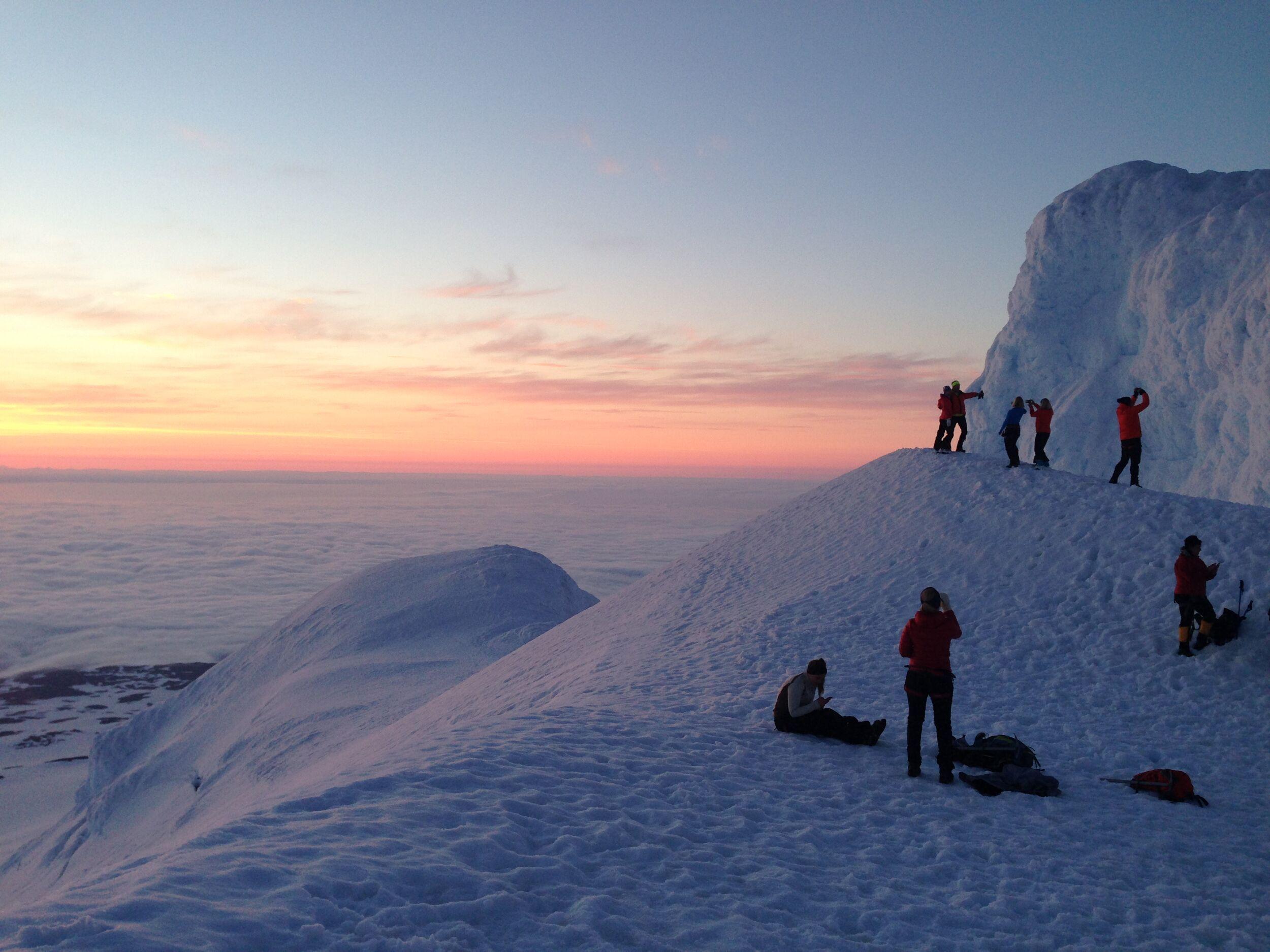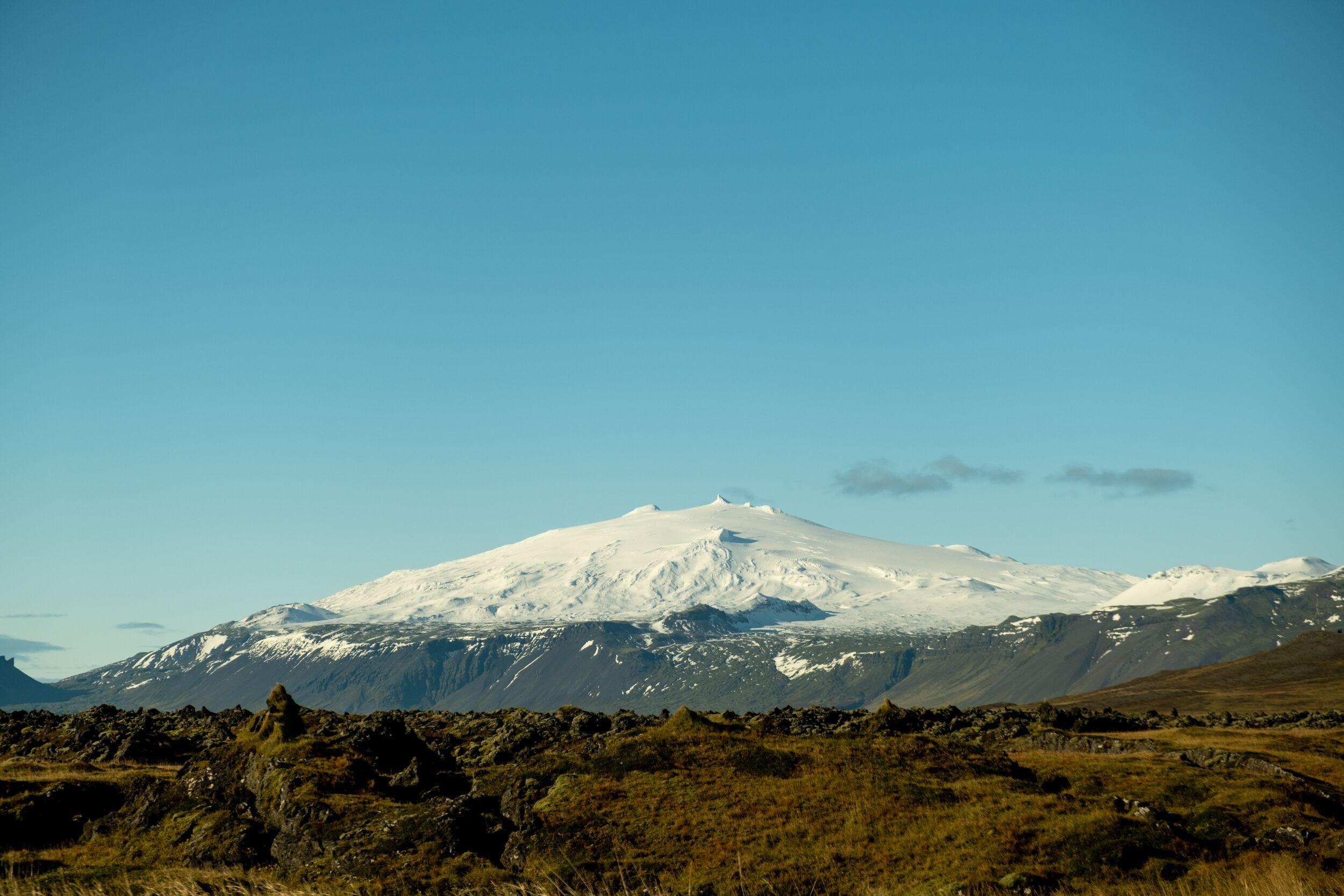
How to visit Snæfellsjökull National Park
As the name suggests, the Snæfellsjökull glacier is in the middle of the Snæfellsnes peninsula which juts out into the North Atlantic Ocean in the west of Iceland. It is an easy drive from Reykjavík if you’re hiring a car and many visitors to Iceland choose to take a road trip around Snæfellsnes to avoid the crowds of the Golden Circle and south coast route, especially in peak season. Snæfellsnes is considered ‘Iceland in miniature’ due to its diverse and unique landscape. From ancient lava tunnels and plains of volcanic rock to the vast frozen expanse of Snæfellsjökull glacier, you can really get a feel for the Land of Ice and Fire on this small outcrop.
If you are driving to Snæfellsjökull yourself, all you need to do is follow the Route One main road north out of Reykjavík and change onto Road 54 which runs from Borgarnes to the tip of the Snæfellsnes peninsula. Following this route takes you straight to the turn-off for Snæfellsjökull (the F-570). The entire drive takes around three hours and there are plenty of attractions and natural wonders to stop at along the way – natural hot springs, waterfalls, fjords and beaches. If you would rather leave the driving to someone else, there are a variety of guided day trips and multi-day trips covering the highlights of the Snæfellsnes peninsula that include transfers from Reykjavík.
Hiking Snæfellsjökull Glacier
Snæfellsjökull is a stratovolcano topped by an ice cap and it is the highest point of the Snæfellsnes peninsula. The 7-to-8-kilometre route from the glacier base to the summit can take anywhere between 3 and 6 hours and involves a lung-testing 750 metres (2,500 feet) of ascent.
Due to the relatively long distance, glacial terrain and steep ascents, the Snæfellsjökull hike is considered ‘challenging’ and suits those with some climbing, hiking or mountaineering experience with a decent level of fitness.
Those embarking on the hike need the correct equipment such as crampons, helmets, ice axes and ropes. It’s worth noting that glacier hiking is not possible in Iceland without a trained professional guide and joining a guided tour of Snæfellsjökull means you’ll be fitted with all the essential equipment. You should make sure to wear a sturdy, waterproof pair of hiking boots that you can fit a set of crampons over (boots, not shoes) and bring layers for the hike. At the bottom of the glacier, you might be cold so having a t-shirt, fleece and waterproof jacket is a good idea. As you climb, your body will warm up and you can de-layer as you go.
Sights between Snæfellsjökull and Reykjavík
The drive from Reykjavík to Snæfellsjökull is a beautiful experience in itself and there are myriad wonders to see along the way. You can take the fastest route through the Hvalfjörður Tunnel, or add another 45 minutes to the journey and enjoy the scenery around the Hvalfjörður fjord, like rushing waterfalls and silent hills flanking the glass-like lake. In Borgarnes, those travelling with kids can appreciate a leg-stretching stop at what might be Iceland’s coolest playpark or a stroll along the waterfront. Once on the peninsula, you can stop at the Ytri Tunga beach where a colony of seals make their home and the towering cascade of Bjarnarfoss waterfall flows over rocks streaked tiger-stripe-orange with old lava deposits.
Attractions and trails near Snæfellsjökull
The area around the Snæfellsjökull National Park is a beguiling land of volcanic rock, hidden gorges and striking seaside cliffs. One of the best walking routes in Iceland is a short drive from Snæfellsjökull in the pretty fishing village of Arnarstapi.
From the village centre, you can follow the cliffside walk past a beautiful sea arch to the small settlement of Hellnar. The trail is about 2.5 kilometres long, so it’s an excellent way to warm up your legs before the challenging hike up to Snæfellsjökull’s summit. Just outside the village or Arnarstapi, you’ve also got a quick yet steep trail up to the top of Stapafell – a small mountain overlooking the village.
Between Búðir and Arnarstap, you’ll find the fairytale-like Rauðfeldsgjá Gorge where a short walking trail leads from the roadside to this moss-speckled wonder. A river trickles through the gorge and a visit here feels as though you have stepped into the pages of a fantasy novel.
All About Snæfellsjökull
You can see Snæfellsjökull from Reykjavík on a clear day even though it is out on the Snæfellsnes peninsula, nearly 120 kilometres from the capital as the crow flies. This is because the Snæfellsnes peninsula curls around the bay of Faxaflói. Of course, with Iceland’s notoriously wild weather, getting a clear day in Reykjavík is not that common.
Snæfellsjökull rose to fame after it was featured in Jules Verne’s book Journey to the Centre of the Earth as the intrepid explorers climbed the glacier to enter the chasm into the Earth’s core.
There must be something other-worldly about Snæfellsjökull because in November 1993 a group of people gathered on top of Snæfellsjökull to welcome aliens to Earth. The group sang songs and held hands, but there is no video or photographic evidence that the aliens visited Snæfellsjökull that day.
Snæfellsjökull stands at 1446 metres above sea level and it is the 8th highest glacier in Iceland.
On a clear day, you can see the white expanse of Snæfellsjökull from Reykjavík.
In terms of driving distance, Snæfellsjökull is 198 kilometres (around 123 miles) from Reykjavík and it takes approximately three hours to get here by car. If you are driving yourself from Reykjavík, you will need to follow the Route One main road north out of the capital and change onto Road 54 at Borgarnes. This road leads along the length of the Snæfellsnes Peninsula and turning onto the F-570 road near Arnarstapi will see you at the base of Snæfellsjökull glacier.
While the ‘æ’ might look strange to an English speaker, pronouncing Snæfellsjökull is quite easy. It is said like Snay-fells-yeh-kohl. The ‘ö’ is pronounced like a vowel somewhere between an ‘e’ and an ‘a’ and the ‘j’ in Icelandic words is usually said softly, more like a ‘y’ in English.
It is possible to climb to the summit of Snæfellsjökull which stands at a mighty 1446 metres above sea level. However, most guided glacier hikes stop at 1418 metres where the view out over the Snæfellsnes peninsula is just as glorious. The final metres to the summit are a steep slope of ragged rock and ice which is a big challenge, but it can be done.
The Snæfellsjökull glacier is a vast ice cap, sitting atop a stratovolcano. While Iceland is constantly simmering with volcanic activity, the last eruption of this particular volcano was over 1,800 years ago. Snæfellsjökull is considered an active volcano as it has the potential to erupt in the future.
The entire hike across Snæfellsjökull tends to take between 3 and 6 hours and the first 40 to 60 minutes of that involves the walk to the beginning of the glacier from the car park and base. So, altogether you would spend around 2 and 4 hours on Snæfellsjökull itself.
The volcanic range that contains Snæfellsjökull is estimated by geologists to be around 700,000 years old. The ice cap itself will have been formed over thousands of years, but the exact date of its birth is difficult to pinpoint. Snæfellsjökull and the surrounding area was declared a national park in 2001.
In terms of glacier hikes in Iceland, the Snæfellsjökull hike is quite a long distance. The entire route is between 7 and 8 kilometres and tends to take between 3 and 6 hours to complete, depending on snow conditions. It involves a total of 760 metres (about 2,500 feet) of climbing and you’ll need professional equipment like crampons, ice axes and helmets to make the hike. The Snæfellsjökull route is considered a challenging hike, so you’ll need a decent level of fitness and need to be ok with walking up steep ascents in difficult conditions. It is worth noting that glacier hiking in Iceland can only be done under the guidance and supervision of a professional hiking guide, so you cannot embark on a Snæfellsjökull glacier hike on your own.
For those that enjoy outdoor adventures, the Snæfellsjökull glacier is definitely worth visiting. It is the only place on the Snæfellsnes peninsula where you can embark on a glacier hike and those that summit this vast ice cap are rewarded with expansive views of the surrounding volcanic landscape. Hiking Snæfellsjökull is certainly a challenging ordeal and would best suit those with a bit of hiking or climbing experience. However, if you’re enjoying a self-drive adventure along the Snæfellsnes peninsula, it is worth pausing at the base of Snæfellsjökull just to admire this natural wonder from ground level. There is a Snæfellsjökull viewpoint along the peninsula’s main road which is marked on Google Maps.
The average hiking time for Snæfellsjökull depends on snowfall and season. When the glacier is frozen and there is little snow on top of the ice cap, the hike tends to take between 3 to 5 hours. However, when there is deep snow to navigate, the hike can take between 5 and 6 hours.
Snæfellsjökull National Park is one of three national parks in Iceland. While each park is staffed with rangers who are there to provide information and keep you safe during your visit, there is no fee to enter any of the national parks on the island. So, it is completely free to go to Snæfellsjökull National Park. It is also free to use the Snæfellsjökull visitor’s centre where you can find information about hiking and things to do in the area.
Related tours

- Limited availability!
Iceland Eclipse 2026 Glacier Hike – Summit Snæfellsjökull for Totality
Hike to the peak of Iceland’s most mystical glacier-volcano for an unbeatable view of the Iceland Eclipse 2026. This once-in-a-lifetime tour offers an epic glacier ascent, panoramic views, and a front-row seat to one of nature’s rarest celestial events - above the clouds!

Snæfellsjökull Summit Hike
This is a thrilling one-day hike to the summit of Snæfellsjökull glacier, the crown jewel of the Snæfellsnes Peninsula. This challenging journey rewards hikers with breathtaking views, fascinating geological formations, and the triumphant feeling of conquering one of Iceland's most picturesque glaciers.

